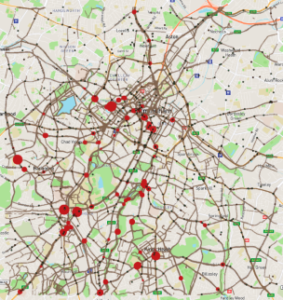
Photo: SeeSense_small
Data-driven Birmingham cycle study reveals collision blackspots
10 September 2021
by Christopher Carey
A cycle safety study funded by the UK’s Department for Transport has revealed some of the most dangerous locations for cyclists in Birmingham.
Over a six-month period, 200 cyclists covered almost 42,000 kilometres as part of the Cycle Smart Brum study – relaying billions of lines of data through specially fitted sensors.
The technology – fitted on the bike’s light – gathers data such as crash events, near-miss incidents, abrupt acceleration and deceleration, swerving, road conditions, average speeds, dwell time and other rider feedback.
The light operates in tandem with a smartphone app, which logs the data, while additional safety features include a brighter flash in high-risk situations, such as junctions and when riders brake.
Researchers from the Royal Society for Prevention of Accidents (RoSPA) and smart bike-light firm See.Sense say the findings from the project are currently being used by Transport for West Midlands (TfWM) and Birmingham City Council to pinpoint potential collision blackspots.

“They [are using] the data from this [project] to identify ‘close pass’ hotspots, so that the police know where to set up enforcement areas,” Irene McAleese Co-founder & CSO, See.Sense, told Cities Today.
Collisions underreported
Research on bicycle collisions in the UK primarily relies on ‘lag’ indicators such as STATS19 reports filed by police, which are usually only used when there has been a serious injury or death.
David Walker, RoSPA’s Head of Road and Leisure Safety, said: “Cycling collisions are typically underreported and therefore it’s vital that we understand more about their causes so that road safety can be improved.”
“This is why we are really excited about this research, which highlights how the swerving and braking data forms ‘lead-indicators’ that can help cities prioritise their safety interventions, or act as a tool to analyse an area based on other indicating data, such as reports from cyclists,” added Walker.
The data gathered during the six-month study enabled researchers to form what they say is “an extraordinarily accurate” picture of locations in the city where riders most frequently experienced ‘near miss’ or ‘close pass’ incidents that did not result in collisions and therefore were usually not reported to police.
Coventry project
Speaking at a recent Cycle Active City webinar, Christopher Kerrigan, Senior Performance Analyst, Transport for West Midlands, said: “We decided to launch a number of ‘close pass’ campaigns this summer, but first we needed to decide their locations, and we were a bit stumped.
“We had the STAT19 data and our infrastructure data but we really didn’t have anything else to quantify what a ‘close pass’ would be, but with this extra layer of data from See.Sense, we were able to access data which previously wasn’t available.”
Earlier this week, TfWM launched a call for participants for a second bicycle safety project in Coventry, set to start in November 2021.











